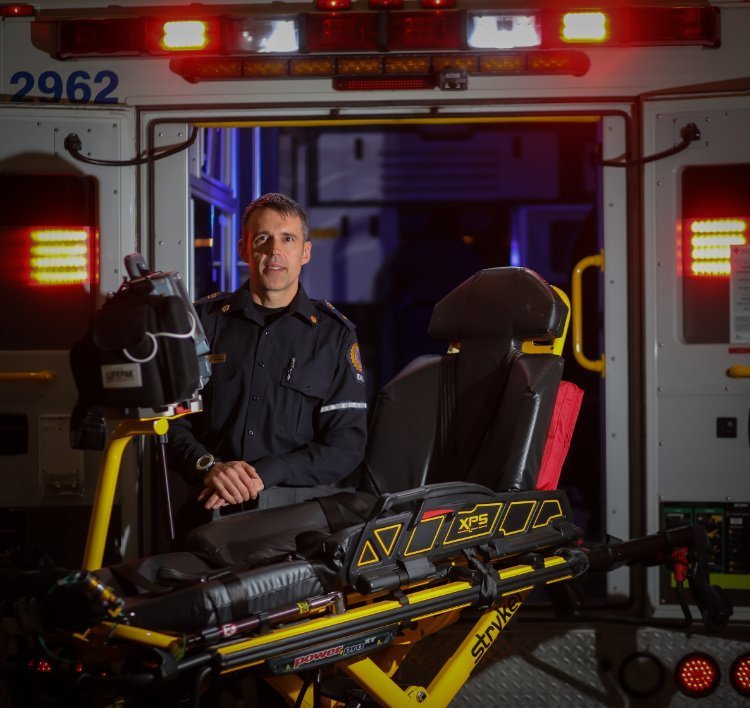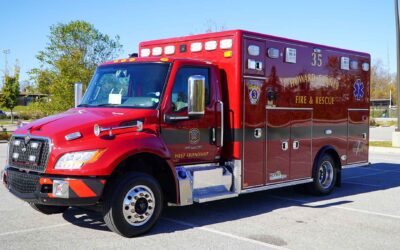
Albert Health Service (AHS) EMS showed off new ambulances Friday featuring design enhancements that have made the patient compartment safer for patients and paramedics. Among the changes: Improved overall layout and seat design to encourage seat belt use, rounded corners on interior surfaces to prevent injuries, and additional work surfaces. (Photos provided by Albert Health Service EMS)
Ian Blanchard remembers his last day working in the back of an ambulance well. It was the day his career caring for patients one-on-one came to an early and unplanned end.
“I was stepping over some cables that ran from the stretcher to a monitor on the side counter, and I grabbed onto the stretcher for support, but the mechanism broke and the stretcher collapsed and I started to fall,” recalls Blanchard. “There was a very frail, sick and elderly patient on the stretcher and I knew I just couldn’t land on her, so I kind of aimed myself over her as best I could and landed on the floor in a small stairwell that’s off to the side.”
Blanchard already had some back problems, so this dramatic fall re-injured him significantly. That meant he was no longer able to continue the physically demanding daily work as a paramedic. But with years of valuable experience, and with formal training and a passion for research, he was able to continue his career.
With support of senior leadership, Blanchard was able to begin building a formalized plan to put trusted research into practice at Albert Health Service (AHS) EMS, culminating in a new role as Provincial Research Lead, in the Office of the Chief Paramedic.
A very personally rewarding project for Blanchard has been working with EMS and University of Calgary colleagues, and Canadian ambulance manufacturers on redesigning the interiors of ambulances to make them safer for paramedics and patients—preventing injuries like the one he suffered.
“I was at a research lecture at the University of Calgary and after the talk, Dr. Bill Ghali introduced me to Dr. Jeff Caird, who is a human factors expert and at the time was designing Emergency Department resuscitation bays here in Calgary.”
From that initial encounter the idea to look at ambulance design took shape.
“The first step was to get our EMS team together with Dr. Caird’s team from the Ward of the 21st Century or W21C,” recalls Blanchard. “We needed to figure out how to observe different paramedics providing care to the same patient, in a way that recorded what they were doing and even where they were looking—all on a limited budget,” explains Blanchard.
The solution was to equip a new ambulance with the latest in video technology, including special eye-gaze tracking goggles and run simulated scenarios as part of routine paramedic training.

This is the first major provincial study of its kind in Canada where ambulance design is being reconsidered. The information gleaned here in Alberta is being shared with other provinces and jurisdictions across North America.
“Ambulances that are safer for paramedics are safer too for patients,” explains EMS Chief Paramedic Darren Sandbeck. “When we are able to reduce the likelihood of the paramedic needing to—even carefully—navigate around a moving vehicle, there’s less risk of the paramedic being hurt during a sudden stop or evasive maneuver, and thus less risk to the patient. It is a win-win situation.”
The study was funded through the AUTO21 Network of Centres of Excellence, with significant in-kind contribution from the University of Calgary W21C Research and Innovation Centre, and Alberta Health Services Emergency Medical Services.
The study entitled, The evaluation of an ambulance rear compartment using patient simulation: Issues of safety and efficiency during the delivery of patient care was published earlier this year in Applied Ergonomics. It took place over approximately 18 months in all five AHS zones, and observed almost 50 paramedic teams in a simulated scenario in the back of a moving ambulance.
“Until now, ambulance design has been largely focused on equipment and gear needed in the patient compartment,” says Blanchard. “This is one of the first studies done where the focus was on how paramedics actually use an ambulance when providing active care.”
“We spent nearly two years working with frontline paramedics, studying how they moved around in an ambulance, where they looked, where they tended to reach, or support themselves when they were moving around,” says Mike Plato, EMS Associate Executive Director of Business Standards and Operations Support. “We know that it’s safest when the paramedic can provide care from one of the three seats in the patient compartment, safely belted in, so part of what we wanted to do was see how we needed to reconfigure the area around the seats to keep paramedics from needing to get up as much; this is called Safety Oriented Design.”

Some of the key changes that have been brought into newly delivered ambulances thanks to Safety Oriented Design principals are:
- Improving overall layout and seat design to allow paramedics the ability to perform their job from the seated position and encourage seatbelt use
- Rounding corners on interior surfaces to prevent injuries
- Adding lips or rounded edges to counters to prevent falling objects
- Putting most-used tools and equipment in easy reach of the primary caregiver seat
- Placing garbage and sharps containers in better proximity to the most used seat
- Additional grab handle added for stability
- Adding a hydraulic lift for main oxygen tank
- Additional work surfaces added (drawers, pull out shelving)
- Addition of an oxygen port in the ceiling of the patient compartment, to reduce tubing trip hazards
“These design changes come at no additional cost to AHS EMS,” explains Plato. “As the second largest ambulance service in Canada, buying approximately 60-70 new ambulances per year as part of a lifecycle replacement program, AHS EMS has been working directly with manufacturers and is able to influence the design of new ambulances as they are developed.”
That means these design changes are already being seen in new ambulances, and have been happening slowly for several years already.
These Safety Oriented Design changes are just one of the initiatives within AHS EMS designed to improve employee and patient safety.
EMS recently introduced new Stryker power cots and power load systems, which have also contributed to a significant reduction in paramedic injuries. A specially designed arm called a Technimount will also allow the heart monitor-defibrillator unit, that typically is secured on a counter inside the ambulance, to now be attached directly to the stretcher, meaning no trailing wires for paramedics to step over and the elimination of trip hazards from wires and cables.
That innovation alone might have been enough to prevent Blanchard’s fall.
“These changes might seem slow or incremental year by year, but when you add up the total of all these changes, they’re significant,” Blanchard explains. “This study is an important example of how research and knowledge translation can inform tangible changes. I believe that AHS EMS is leading the way with these proactive upgrades—and hopefully it can prevent one of my coworkers from experiencing the same type of injury that took me off the street.”




